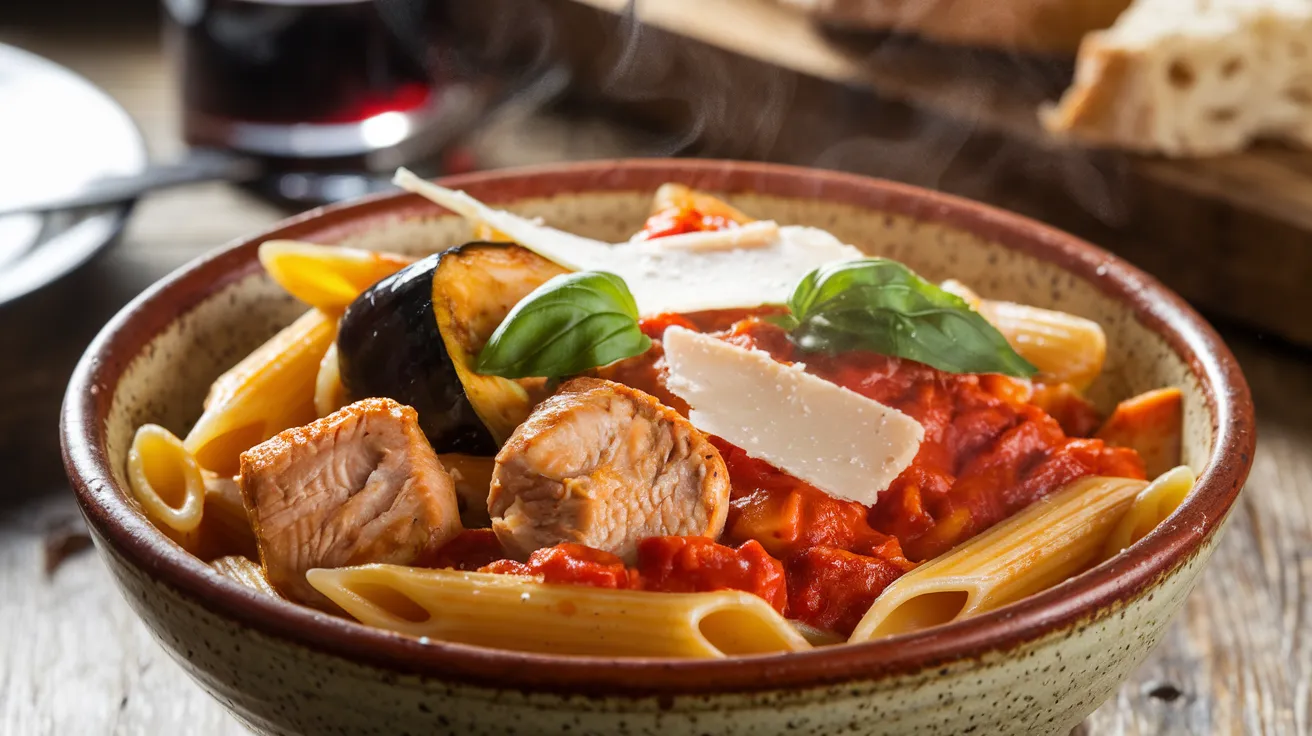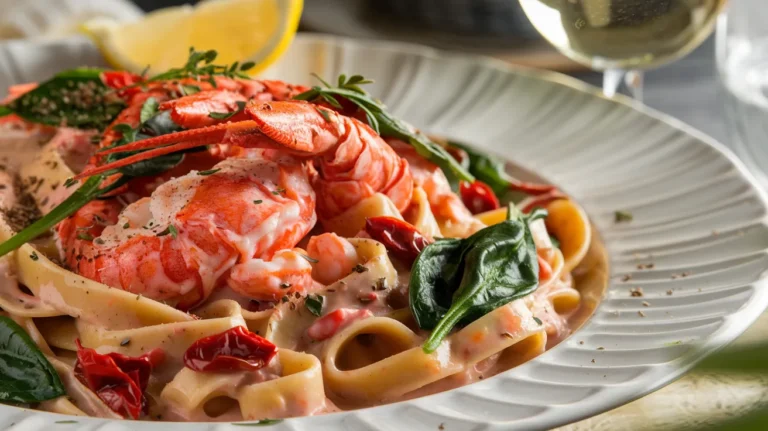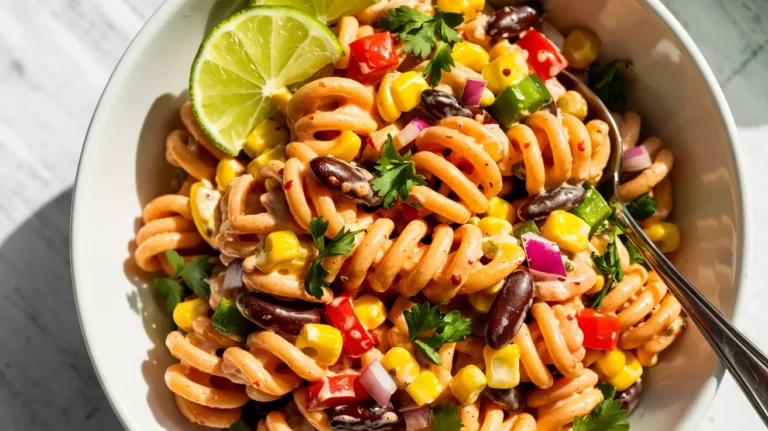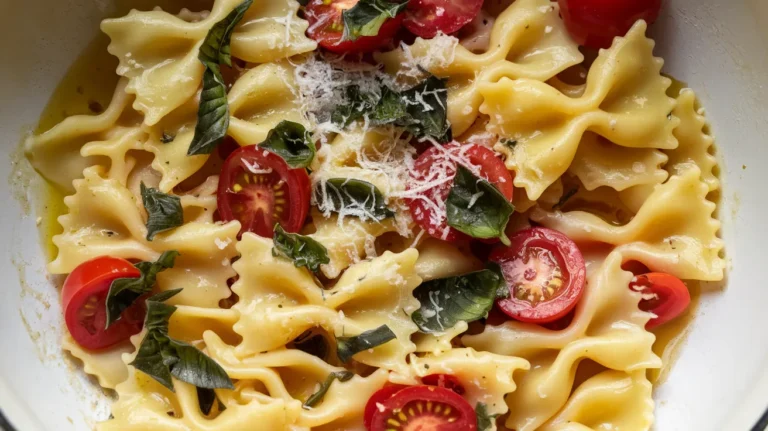Prep Time: 20 minutes | Cook Time: 35 minutes | Total Time: 55 minutes | Servings: 4 persons
Key Takeaways
- This Chicken Aubergine Pasta combines protein, vegetables, and carbs for a complete meal
- The secret to perfect aubergine is salting it before cooking to remove bitterness
- You can make this dish ahead and reheat it for busy weeknights
- Easily adaptable for gluten-free or vegetarian diets with simple swaps
Why This Chicken Aubergine Pasta Works
Ever stood in your kitchen, staring at chicken and aubergine, wondering how to turn them into something amazing? You’re not alone.
Most Chicken Aubergine Pasta recipes leave you with bland results or mushy vegetables.
This recipe solves both problems. The trick? Cooking each ingredient separately before combining them creates perfect textures and rich flavors in every bite.
Perfect for family dinners, this Chicken Aubergine Pasta serves exactly 4 people with generous portions that even picky eaters will love. The technique is similar to my creamy eggplant pasta but with added protein and a different flavor profile.
Nutrition Information
| Nutrient | Amount per Serving |
|---|---|
| Calories | 520 |
| Protein | 32g |
| Carbohydrates | 58g |
| Fat | 18g |
| Fiber | 6g |
| Sodium | 380mg |
What You’ll Need
Ingredients
| Ingredient | Amount | Notes |
|---|---|---|
| Boneless, skinless chicken breasts | 1.5 pounds (680g) | Cut into 1-inch cubes |
| Aubergine (eggplant) | 1 large (about 1.5 pounds/680g) | Cut into 1-inch cubes |
| Penne pasta | 12 ounces (340g) | Any short pasta works |
| Olive oil | 3 tablespoons | Divided |
| Garlic | 4 cloves | Minced |
| Red bell pepper | 1 medium | Diced |
| Red onion | 1 medium | Diced |
| Crushed tomatoes | 1 can (14 oz/400g) | |
| Tomato paste | 2 tablespoons | |
| Chicken broth | 1 cup (240ml) | Low sodium preferred |
| Dried oregano | 1 teaspoon | |
| Dried basil | 1 teaspoon | |
| Red pepper flakes | ¼ teaspoon | Optional, for heat |
| Salt | 1 teaspoon | Plus more for salting aubergine |
| Black pepper | ½ teaspoon | Freshly ground |
| Fresh basil | ¼ cup | Chopped, for garnish |
| Parmesan cheese | ½ cup (50g) | Freshly grated |
Kitchen Tools
| Tool | Purpose |
|---|---|
| Large pot | For boiling pasta |
| Large skillet or sauté pan | For cooking chicken and vegetables |
| Colander | For draining pasta |
| Cutting board | For prep work |
| Chef’s knife | For cutting ingredients |
| Measuring cups and spoons | For accurate measurements |
| Wooden spoon | For stirring |
| Paper towels | For draining aubergine |
Possible Substitutions
- Pasta: Use gluten-free pasta for a gluten-free version
- Chicken: Substitute with turkey, or use firm tofu for a vegetarian option
- Aubergine: Zucchini or mushrooms can work if you don’t have aubergine
- Crushed tomatoes: Use 4-5 fresh tomatoes, diced, plus 2 tablespoons tomato paste
- Parmesan: Nutritional yeast makes a good dairy-free alternative
Detailed Beginner-Friendly Instructions
Preparation Phase
- Set up your workspace:
- Clear your countertop to give yourself plenty of room
- Place your cutting board on a stable surface
- Put a small bowl next to your cutting board for food scraps
- Read through the entire recipe once before starting
- Wash your hands thoroughly with soap and warm water
- Prepare the aubergine:
- Rinse the aubergine under cool water and pat dry with a paper towel
- Place the aubergine on your cutting board with the stem end facing up
- Using your chef’s knife, cut off the stem end (about ¼ inch)
- Cut the aubergine in half lengthwise, from top to bottom
- Lay each half flat-side down on the cutting board
- Cut each half into ½-inch strips lengthwise
- Turn the strips and cut crosswise to create 1-inch cubes
- Place all the cubes in a colander in the sink
- Sprinkle 1 tablespoon of salt evenly over all the aubergine pieces
- Gently toss the aubergine with your hands to distribute the salt
- Let the aubergine sit for 15-30 minutes (this pulls out bitter juices)
- BEGINNER TIP: Don’t skip this salting step! It’s crucial for getting rid of the bitterness in aubergine
- While the aubergine is sitting, prepare the chicken:
- Place chicken breasts on a clean cutting board (use a separate one from vegetables if possible)
- Trim off any visible fat using your knife
- Cut the chicken into even 1-inch cubes, trying to keep them all the same size
- BEGINNER TIP: Partially freezing the chicken for 15 minutes makes it easier to cut
- Place the chicken cubes in a clean bowl
- Wash your hands immediately after handling raw chicken
- Clean your cutting board thoroughly before proceeding
- Prepare the vegetables:
- For the red onion:
- Cut off both ends of the onion
- Cut the onion in half from top to bottom
- Peel off the papery skin
- Place each half flat-side down
- Make vertical cuts about ¼-inch apart, but don’t cut all the way through the root end
- Make horizontal cuts across the vertical cuts to create small dice
- For the red bell pepper:
- Stand the pepper upright on your cutting board
- Cut down one side, staying close to the core with the seeds
- Rotate and continue cutting around the core until you have removed all the flesh
- Discard the core and seeds
- Place the pepper pieces skin-side down and cut into strips
- Turn the strips and cut crosswise to create small dice
- For the garlic:
- Separate one clove from the head
- Place the flat side of your knife over the clove
- Press down firmly with the heel of your hand to crush the clove
- The skin should now be easy to remove
- Mince the garlic by making very fine cuts in multiple directions
- Repeat with remaining cloves
- BEGINNER TIP: A garlic press works well if knife skills are challenging
- For the red onion:
- Rinse the aubergine:
- After the aubergine has sat for at least 15 minutes with salt
- Rinse thoroughly under cold running water, gently turning with your hands
- Make sure all salt is rinsed away
- Spread the aubergine cubes on several layers of paper towels
- Pat completely dry with additional paper towels (moisture will prevent browning)
- BEGINNER TIP: Drying the aubergine thoroughly is key for proper browning
- Start cooking pasta:
- Fill a large pot about ¾ full with water (about 4 quarts/4 liters)
- Place on stove over high heat
- Add 1 tablespoon salt to the water (it should taste like seawater)
- Bring to a rolling boil (large bubbles that don’t stop when stirred)
- Add the pasta to the boiling water, stirring immediately to prevent sticking
- Set a timer for 2 minutes less than the package directions suggest
- Stir occasionally while pasta cooks
- Before draining, scoop out ½ cup of the pasta cooking water with a measuring cup
- Drain pasta in a colander in the sink, but don’t rinse
- BEGINNER TIP: Cooking pasta slightly underdone (al dente) is important as it will cook more in the sauce
Cooking Phase
- Cook the chicken:
- Place your large skillet or sauté pan on the stove over medium-high heat
- Add 1 tablespoon olive oil and tilt the pan to coat the bottom evenly
- Allow the oil to heat until it shimmers (about 30 seconds)
- Sprinkle chicken with ¼ teaspoon salt and ¼ teaspoon pepper
- Carefully add chicken pieces to the hot oil in a single layer (you should hear a sizzle)
- BEGINNER TIP: Don’t overcrowd the pan—work in two batches if needed
- Let the chicken cook undisturbed for 2 minutes until golden brown on one side
- Using tongs or a spatula, turn each piece to cook on other sides
- Cook for another 2-3 minutes until no pink remains and chicken reads 165°F on a thermometer
- Remove chicken to a clean plate using tongs or a slotted spoon
- Leave any drippings in the pan for added flavor
- Cook the aubergine:
- Using the same pan with the chicken drippings, add another tablespoon of olive oil
- When the oil is hot, add the dried aubergine cubes in a single layer
- BEGINNER TIP: Like the chicken, cook in batches if your pan is not large enough
- Let the aubergine cook undisturbed for 3 minutes to develop a golden crust
- Stir or flip the pieces and continue cooking for another 3-5 minutes
- Aubergine is done when pieces are golden brown on multiple sides and softened
- Remove to the plate with the chicken
- Create the sauce base:
- Add remaining tablespoon of olive oil to the same pan
- Reduce heat to medium
- Add the diced onion and bell pepper
- Stir occasionally with a wooden spoon, scraping up any browned bits from the bottom
- Cook for 4-5 minutes until vegetables are softened but not browned
- Add the minced garlic and stir constantly for 30 seconds
- BEGINNER TIP: Garlic burns easily and becomes bitter, so watch it carefully
- Add tomato paste and stir continuously for 1 minute until it darkens slightly
- Build the sauce:
- Add the can of crushed tomatoes to the pan
- Pour in the chicken broth
- Add dried oregano, dried basil, remaining salt (½ teaspoon), pepper, and red pepper flakes
- Stir everything together until well combined
- Increase heat to bring to a gentle simmer (small bubbles around the edge)
- Reduce heat to maintain a simmer without boiling
- Simmer uncovered for 5 minutes, stirring occasionally
- BEGINNER TIP: Taste the sauce now and adjust seasonings if needed
Assembly Phase
- Combine all components:
- Return the cooked chicken and aubergine to the pan with the sauce
- Add the drained pasta
- Using two wooden spoons or a pair of tongs, gently fold everything together
- Make sure all pasta is coated with sauce
- If the mixture seems too dry or thick, add the reserved pasta water a few tablespoons at a time
- Continue to fold until everything is evenly distributed
- Simmer for 2-3 minutes over medium-low heat, stirring gently
- BEGINNER TIP: This final simmer allows the pasta to absorb some sauce and flavors to meld
- Finish the dish:
- Remove the pan from heat
- Add half of the chopped fresh basil (about 2 tablespoons)
- Gently stir to incorporate
- Taste again and adjust salt and pepper if needed
- Sprinkle the grated Parmesan cheese evenly over the top
- Allow it to sit for 2 minutes to melt slightly
- Top with remaining fresh basil
- BEGINNER TIP: Tearing basil leaves instead of cutting prevents browning edges
Serving Suggestions
- Serve the dish:
- Scoop equal portions into 4 bowls or plates using a large serving spoon
- Each portion should be about 1½ cups
- Place extra Parmesan cheese on the table in a small bowl with a spoon
- Serve with a simple green salad dressed with olive oil and lemon juice
- Offer crusty bread on the side to soak up extra sauce
- BEGINNER TIP: Warm the serving plates in a low oven (200°F/90°C) for 5 minutes for a restaurant-quality touch

Common Problems and Solutions
Troubleshooting
| Problem | Solution |
|---|---|
| Pasta is mushy | Cook pasta 2 minutes less than package directions. It will continue cooking when added to the sauce |
| Aubergine is bitter | Don’t skip the salting step, which removes bitterness. Rinse thoroughly to remove excess salt |
| Sauce is too thick | Add reserved pasta water a tablespoon at a time until desired consistency |
| Sauce is too thin | Simmer uncovered for a few extra minutes to reduce |
| Chicken is dry | Don’t overcook it—remove from pan as soon as it’s cooked through |
| Dish lacks flavor | Taste before serving and adjust with more salt, pepper, or a splash of balsamic vinegar |
| Aubergine won’t brown | Make sure it’s completely dry after rinsing and that your pan is hot enough |
| Garlic has burned | If this happens, it’s best to remove it and start again with fresh garlic |
| Ingredients sticking to pan | Make sure there’s enough oil and that you’re not using too high heat |
Variations and Substitutions
Make It Your Own
- Spicy version: Double the red pepper flakes and add 1 finely chopped jalapeño with the bell pepper. If you enjoy heat, you might also like my Blackened Chicken Pasta for another spicy option.
- Creamy version: Stir in ½ cup of heavy cream or cream cheese at the end
- Meaty version: Add ½ pound Italian sausage, browned and crumbled, along with the chicken
- Vegetarian version: Skip the chicken and double the aubergine, or add 2 cups mushrooms
- Mediterranean twist: Add ½ cup Kalamata olives and ½ cup crumbled feta instead of Parmesan
- Budget-friendly: Use chicken thighs instead of breasts (they’re cheaper and more flavorful)
- Whole grain option: Use whole wheat pasta for more fiber
- Low-carb version: Use half the pasta and add 2 cups of baby spinach at the end
Storage and Reheating
Keep It Fresh
- Refrigerator storage:
- Allow dish to cool completely (no more than 2 hours at room temperature)
- Divide into portioned containers with tight-fitting lids
- Label with date and contents
- Store in refrigerator for up to 3 days
- Pasta will absorb sauce as it sits, so it may be thicker when cold
- Freezer storage:
- Cool completely before packaging
- Use freezer-safe containers or heavy-duty freezer bags
- Remove as much air as possible
- Freeze in portion-sized amounts for easier thawing
- Leave ½-inch space at top of containers for expansion
- Label with name, date, and contents
- Freeze for up to 2 months
- BEGINNER TIP: Freeze flat in freezer bags to save space and allow quick thawing
- Reheating from refrigerated:
- Microwave method:
- Place portion in microwave-safe dish
- Cover loosely with microwave-safe lid or paper towel
- Heat on medium power (70%) for 2 minutes
- Stir well
- Continue heating in 30-second intervals until hot throughout (165°F/74°C)
- Stovetop method:
- Place in a saucepan over medium-low heat
- Add 2-3 tablespoons water or broth per portion
- Cover and heat for 5-7 minutes, stirring occasionally
- BEGINNER TIP: Add a few fresh basil leaves and a drizzle of olive oil after reheating to refresh flavors
- Microwave method:
- Reheating from frozen:
- Thaw overnight in refrigerator (safest method)
- For quick thawing, place sealed bag in bowl of cold water for 30 minutes
- Once thawed, follow refrigerated reheating instructions
- BEGINNER TIP: Never thaw at room temperature as this promotes bacterial growth
Safety Notes and Tips
Cook Smart, Eat Safe
- Raw chicken handling:
- Never use the same cutting board for vegetables after cutting raw chicken without washing thoroughly
- Wash hands with soap and warm water for 20 seconds after handling raw chicken
- Use a separate knife for chicken or wash thoroughly before using for other ingredients
- Disinfect all surfaces that come in contact with raw chicken
- Chicken must reach internal temperature of 165°F (74°C) to be safe
- Food storage safety:
- Don’t leave the finished dish at room temperature for more than 2 hours
- Refrigerate promptly in shallow containers for quick cooling
- Keep cold foods cold (below 40°F/4°C) and hot foods hot (above 140°F/60°C)
- Never taste food that looks or smells questionable
- Preparation tips:
- Read the entire recipe twice before starting
- Gather and measure all ingredients before you begin cooking (mise en place)
- Keep pasta al dente as it will continue cooking in the sauce
- Pat aubergine completely dry after rinsing to ensure proper browning
- BEGINNER TIP: Use separate cutting boards for meat and vegetables (color-coded boards help)
- Time-saving hacks:
- Chop vegetables and chicken the day before and store in separate containers in the refrigerator
- Use pre-minced garlic (1 teaspoon equals 1 clove)
- Look for pre-cubed chicken to save cutting time
- Use an electric kettle to boil water faster for pasta
- BEGINNER TIP: Clean as you go to avoid a mountain of dishes at the end
- Flavor boosters:
- Finish with a drizzle of good quality extra virgin olive oil
- Add a splash (1 teaspoon) of balsamic vinegar to the sauce
- Toast 2 tablespoons of pine nuts in a dry pan until golden and sprinkle on top
- Add a tiny pinch (⅛ teaspoon) of cinnamon to the sauce for subtle warmth
- Grate fresh lemon zest over the final dish for brightness
- Try adding a touch of heat with red pepper flakes, similar to my Garlic Chilli Cacio e Pepe for an exciting flavor dimension




